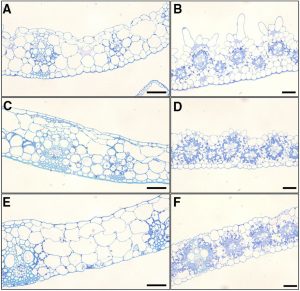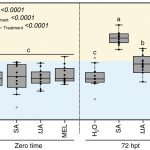On the Inside: Sodium Sequestration by a Turfgrass
 About 20% of irrigated land is considered saline, with the amount of saline soils increasing worldwide. This trend is alarming due to the high salt sensitivity of most crop species. Yield reduction in crops in saline soils amounts to losses in the order of 12 to 27.3 billion US dollars annually. Thus, the improvement of salt tolerance in plants will become increasingly important in coming decades. Seashore paspalum (Paspalum vaginatum) is a halophytic Panicoid grass that can survive in salt concentrations near that of seawater and uses osmolyte production, ion homeostasis, and Na+ exclusion to cope with salt stress. However, its ability to maintain growth while accumulating high levels of Na+ in leaf tissue remains perplexing. Spiekerman and Devos (10.1104/pp.20.00796) have examined the leaf structure and ion content in P. vaginatum accession ‘HI10’, which shows increased growth under saline conditions, and a closely related P. distichum accession ‘Spence’, which shows reduced growth under salt, to better understand ‘HI10’s superior salt tolerance. A striking difference between ‘HI10’ and ‘Spence’ was the high steady-state level of K+ in ‘HI10’. Moreover, the authors report that both Paspalum species contain dense rows of translucent papillae on the adaxial surface. The papillae are unicellular protrusions from epidermal cells and are much larger in ‘HI10’ than ‘Spence’. The ‘HI10’ papillae were shown to act as Na+ sinks when plants were grown under salt stress. Thus, these leaf papillae function as specialized structures for Na+ sequestration in P. vaginatum, illustrating a possible path for biotechnological improvement of salt-sensitive Panicoid crops with analogous leaf structures.
About 20% of irrigated land is considered saline, with the amount of saline soils increasing worldwide. This trend is alarming due to the high salt sensitivity of most crop species. Yield reduction in crops in saline soils amounts to losses in the order of 12 to 27.3 billion US dollars annually. Thus, the improvement of salt tolerance in plants will become increasingly important in coming decades. Seashore paspalum (Paspalum vaginatum) is a halophytic Panicoid grass that can survive in salt concentrations near that of seawater and uses osmolyte production, ion homeostasis, and Na+ exclusion to cope with salt stress. However, its ability to maintain growth while accumulating high levels of Na+ in leaf tissue remains perplexing. Spiekerman and Devos (10.1104/pp.20.00796) have examined the leaf structure and ion content in P. vaginatum accession ‘HI10’, which shows increased growth under saline conditions, and a closely related P. distichum accession ‘Spence’, which shows reduced growth under salt, to better understand ‘HI10’s superior salt tolerance. A striking difference between ‘HI10’ and ‘Spence’ was the high steady-state level of K+ in ‘HI10’. Moreover, the authors report that both Paspalum species contain dense rows of translucent papillae on the adaxial surface. The papillae are unicellular protrusions from epidermal cells and are much larger in ‘HI10’ than ‘Spence’. The ‘HI10’ papillae were shown to act as Na+ sinks when plants were grown under salt stress. Thus, these leaf papillae function as specialized structures for Na+ sequestration in P. vaginatum, illustrating a possible path for biotechnological improvement of salt-sensitive Panicoid crops with analogous leaf structures.



